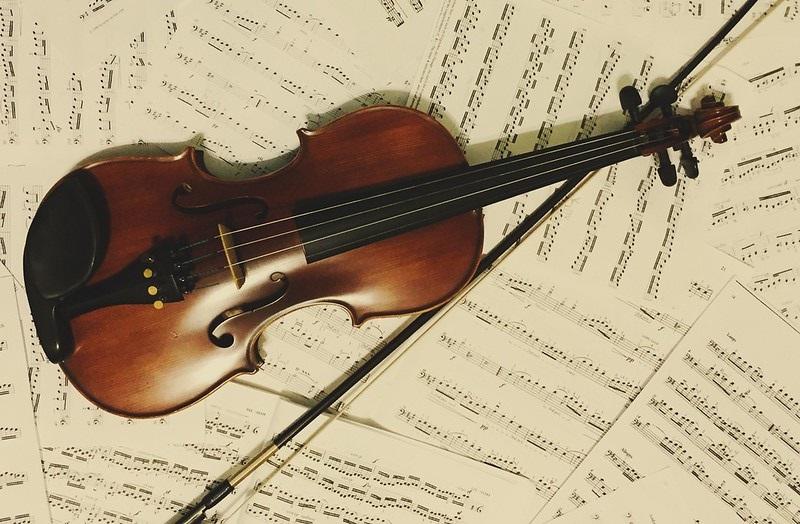If you’re a keen violinist, sooner or later you will have to take a violin exam. As with many other instruments, your proficiency with it is rated by a system of grades.
Each assessment you take will allow you to pass up to the next grade. It’s worth knowing everything there is to know so you can pass with flying colours on every occasion.

How many violin grades are there in the UK?
In the UK, a grade is the system by which you are assessed. This exam consists of various stages, and in total there are 8 violin grades to master (excluding the Initial Grade).
This is the same as other classical instruments like the piano and is governed by the Associated Board of the Royal Schools of Music (ABRSM).
If you have aspirations of going on to study music at university, then you are expected to pass the highest grade (8) before you go. You can also accumulate valuable UCAS points even if you aren’t going to study something music-related.
The benefits of having a grade system like the one in the UK is that it provides you with concrete feedback on what level you’re at with the violin. It also gives you milestones that you can work towards, which provides helpful motivation to stick with it for those moments when your discipline falters.
What You Need To Know About Violin Grades

If you’re new to music grading systems, then there is some basic information you need to know about requirements, what each grade consists of, and how you will be assessed.
Eligibility & Requirements
To qualify for a violin grade exam, you will need to satisfy some criteria:
- Although age or previous experience don’t come into play if you want to take the grade 6, 7, or 8 exams, you will need to have passed at least grade 5 of Music Theory.
- The size and brand of your violin is down to personal preference, so long as it is acoustic.
- To pass an exam, you must earn at least 100 marks. 120 marks will earn you a Merit, and 130 is worth a Distinction. The highest mark you can get is 150.
Start taking violin lessons near me today!
Violin Grade Marking Criteria
It’s always useful to know what exactly it is you will be judged on in an exam, and a violin exam should be no exception.
The way that the ABRSM marks your performance in the exam is by adding or subtracting from the pass score (100), rather than starting from 0.
You don’t need to pass every section of the exam to pass overall.
However, you will want to do well on every section if you have any aspirations of earning a Merit or Distinction in the exam. Here's a breakdown of your grading:
| Exam Section | Assessment Criteria |
|---|---|
| Pieces | Marked according to pitch, timing, tone, shape, and overall performance. |
| Scales and Arpeggios | Assessed based on pitch accuracy, rhythm maintenance, and musical shape. |
| Sight-Reading | Evaluated on note and pitch accuracy, musical detail, and confidence in performance. |
| Aural Tests | Graded based on accuracy, musical perception, and confidence of response. |
| Overall Exam | Passing overall does not require passing every section, but high performance in all is needed for Merit or Distinction. |
Violin Grade Breakdown
In this section we’re going to breakdown each grade in the UK violin exam, so you know what to expect whichever level you’re at.

Since you can skip grades and try for the grade you believe you’re at right now, it’s worth knowing everything about the grade assessment so you can make an accurate assumption about where you stand.
There are 8 different grades in violin, or 9 if you include the Initial Grade.
| Grade | Description | Requirements | Exam Board |
|---|---|---|---|
| Initial Grade | Introductory level for beginners focusing on basic skills and short pieces | Three pieces, scales, arpeggios, sight-reading, and aural tests | ABRSM |
| Grade 1 | Foundation level introducing more variety in musical pieces | Three pieces from Lists A, B, and C, scales, arpeggios, sight-reading, and aural tests | Forsyths |
| Grade 2 | Builds on foundational skills with slightly more complex pieces | Three pieces, scales, arpeggios, sight-reading, and aural tests | Forsyths |
| Grade 3 | Intermediate beginner level with increased technical demands | Three pieces, scales, arpeggios, sight-reading, and aural tests | Forsyths |
| Grade 4 | Early intermediate level with a broader range of techniques | Three pieces, scales, arpeggios, sight-reading, and aural tests | ABRSM |
| Grade 5 | Intermediate level preparing students for more advanced studies | Three pieces, scales, arpeggios, sight-reading, and aural tests | ABRSM |
| Grade 6 | Advanced intermediate level with significant technical challenges | Three pieces, scales, arpeggios, sight-reading, and aural tests | ABRSM |
| Grade 7 | Pre-advanced level focusing on a wide range of techniques and musical understanding | Three pieces, scales, arpeggios, sight-reading, and aural tests | ABRSM |
| Grade 8 | Advanced level requiring high proficiency and musical interpretation | Three pieces, scales, arpeggios, sight-reading, and aural tests | ABRSM |
Each grade requires you to pass an exam, and each exam is made up of 3 pieces, scales and arpeggios, sight-reading, and aural tests.
Violin Pieces
To pass this section of the exam, you will need to choose one piece from each of 3 lists you’re given, and play them to the best of your ability.
The 3 different lists in the exam each require different skills. For example, List A is made up of pieces which suit the musician with technical agility, whereas list B is for the more expressive violinist. List C has a variety of musical traditions and styles, so the pieces will require a slightly different skill set.
A lot of the pieces will require an accompaniment since part of being a musician or violinist is playing in harmony with others or as part of a group. You are responsible for your accompanist, and it can be your teacher if that’s easiest. This ABRSM video provides helpful performance tips for passing your exams:
A lot of how well you do in the eyes of the examiner comes down to your confidence and interpretation of a piece. You aren’t awarded extra marks for performing from memory though.
Scales and Arpeggios
This part of the exam is concerned with your technical ability as a violinist, and will test skills such as hand positioning, finger movement, and overall coordination.
In order to succeed in this section you will need to master the scales and arpeggios and make sure you are pitch perfect and capture the tone with every note. You will need to play each scale and arpeggio from memory, so it’s essential that you know them all by heart.
Sight-reading
Sight-reading is all about your ability to recognise the musical notes, and places emphasis on how quickly you pick up the tone, keys, and common rhythm patterns.
For this part of the exam you will play a short unseen piece of music. You will have 30 seconds to flick through it before you have to play it for the assessment. Different grades will assess you according to more or less advanced criteria in this section.
Aural Tests
The aural tests in a violin exam are designed to evaluate your ability to listen, since it has such an important role in playing.
To do well in this section you will need to have a good sense of the rhythm and the pulse of a piece, amongst other elements.
In this part your voice is what will be assessed, primarily based on pitch. You will be asked to sing, clap, and identify different parts of a piece, led by an examiner who will be playing on the piano.
If you need additional help or prompts from the examiner during the aural tests, this could work against you in your overall mark.

How can you get a distinction on your violin exam?

While a pass is perfectly acceptable, if you strive for the best, then you’ll want to shoot for the stars and aim for the distinction in your violin exam. How can you get a distinction?
In terms of what you need to achieve it, 130 marks out of 150 total. This is 30 more than the 100 needed to pass, and each extra mark will require hours of practise.
There are 4 sections which you will need to master in order to secure a distinction in the violin exam.
These are:
- Pieces
- Scales and arpeggios
- Sight-reading
- Aural tests.
That means it isn’t enough to excel in a single area, you will need to ensure you not only have a sound theoretical knowledge, but you’re also extremely well acquainted with the pieces and the techniques you are required to demonstrate with the instrument.
Improve yourself with violin lessons near me on Superprof.
Can you skip grades in violin?
In short, yes you can.
It is possible to skip grades in violin, and in some cases is actually advised.
While the idea of skipping an exam might seem like a way of putting in less effort and getting ahead, it doesn’t work like that with violin grading.
The idea behind skipping a grade in music is that you are too advanced for a grade, so you skip it and take the exam for the next grade up to save time.
Each grade you acquire makes the previous one obsolete, so in theory if you were to just take grade 4, you would be a grade 4 violinist, regardless of whether or not you took exams for grades 1-3.
Tips to help you prepare for your violin exam
To best prepare for your violin exam, there are some things you can do both with and without the instrument.
In general, you want to ensure you are feeling well-prepared on the day of the exam. Here are most important takeaways for succeeding in your exams:
| Tip/Advice | Description |
|---|---|
| Regular Practice | Consistency is key. Practise regularly to build muscle memory and improve technique. Aim for daily practice sessions, even if they're short. |
| Mock Exams | Simulate the exam environment by performing for friends or family. This helps reduce nerves and familiarises you with playing under pressure. |
| Understand Exam Criteria | Familiarise yourself with the specific requirements and criteria for your grade. Review the syllabus and marking criteria published by ABRSM or your exam board. |
| Feedback from Teachers | Seek regular feedback from a qualified violin teacher. They can provide valuable insights, identify areas for improvement, and offer tailored advice. |
| Record Your Practice | Record yourself playing and review the recordings. This helps you identify mistakes, track progress, and adjust your practice routine accordingly. |
| Use a Metronome | Practise with a metronome to ensure you maintain a steady tempo. This is crucial for accuracy in timing and rhythm. |
| Focus on Weak Areas | Identify and spend extra time on sections where you struggle. Break down difficult passages and practise them slowly before gradually increasing speed. |
| Listen to Professional Recordings | Listening to recordings by professional violinists can provide inspiration and help you understand the desired sound and style for your pieces. |
| Sight-Reading Practice | Regularly practise sight-reading new pieces. This improves your ability to quickly interpret and play unfamiliar music, which is a key part of the exam. |
| Aural Skills | Develop your aural skills by practising clapping rhythms, singing intervals, and identifying chords and modulations. These skills are essential for the aural test component of the exam. |
| Physical Comfort and Posture | Ensure you are physically comfortable while playing. Consider taking lessons in Alexander Technique to improve posture and reduce tension. |
| Group Playing | Participate in orchestras or chamber groups. Playing with others improves your timing, intonation, and musicality, and provides a more enjoyable and motivating practice environment. |
| Use of Mirror | Practise in front of a mirror to check your posture and bowing technique. This visual feedback helps correct mistakes and develop good habits. |
| Varied Practice Techniques | Incorporate different practice techniques such as playing scales with varied rhythms and bowing patterns. This builds versatility and strengthens technical skills. |
| Positive Mindset | Maintain a positive attitude and be patient with your progress. Celebrate small achievements and view mistakes as learning opportunities. |
Some of the most important factors are to make sure you are well hydrated, eat a healthy breakfast, and get a good night’s sleep the night before the exam.
It might sound obvious, but these small things can have a huge impact on your ability to perform at your best.
As for violin-specific advice, you need to practise consistently until you have mastered the pieces you’ll be expected to play for the grade.
This means sticking with each piece until you get to the point at which you have it completely down.
Improve yourself with violin classes London on Superprof.
Fine Tune Your Skills With Superprof
If you’re looking to fine-tune your skills before the day of the exam arrives, then it’s worth considering lessons with a private tutor on Superprof.
The violin tutors you’ll find on the tutoring platform can tailor a programme around your needs, and help prepare you for your all-important grade exam.

























